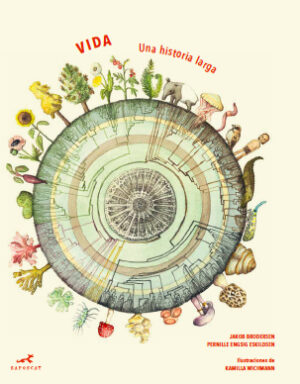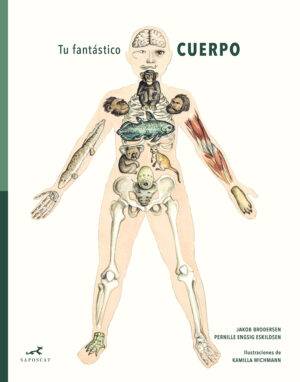Ilustraciones y selección de JooHee Yoon
Versos salvajes. Joohee Yoon
$16.000
50 páginas
Año de publicación 2017
Edad recomendada +5
ISBN: 9789563650440
ISBN: 9789563650440
Versión en español de Marcela Fuentealba
Coedición con Hueders. Comprar.
Edición original: Enchanted Lion Books, Nueva York 2015.
Coedición con Hueders. Comprar.
Edición original: Enchanted Lion Books, Nueva York 2015.
Son 16 poemas sobre animales ilustrados por JooHee Yoon, que eligió sus favoritos de niña y los dibujó con tres colores, a mano y digital, en un libro vibrante e inagotable. Sorprende con páginas desplegables con el clásico “El Tigre” de William Blake hasta la perdida “Oda al picaflor” de Pablo Neruda. Esta versión en español incluye poemas de la tradición latinoamericana, para acercar el humor, el ritmo y la sorpresa de la poesía: Francisco de Quevedo, Nicolás Guillén, Gabriela Mistral, Eugenio Montale.
Hay canciones y adagios anónimos, traducciones de poemas conocidos y desconocidos de Lewis Carroll, Arthur Waugh (padre de Evelyn), Carolyn Wells, Robert Desnos, Laura E. Richards, Hilaire Belloc, Christina Rosetti, Eileen Mathias.
Reseña en New York Times
Leer Reseña
Reseña a la versión inglesa de Versos salvajes de JooHee Yoon en New York Times: Poems don’t necessarily need pictures, nor pictures poems. But children — for whom magic is real and logic overrated — love and need both. In three handsome new poetry collections for children, word and image energize and illuminate each other, becoming journeys for the eye and ear. The word “nursery” in the title “Over the Hills and Far Away: A Treasury of Nursery Rhymes” implies that these poems are for the very youngest children, but my 8-year-old daughter read this book for a long time, saying, “I like that the poems come from all over the world.” Because each of the book’s 77 illustrators gets a two-page spread featuring one to three poems, to turn a page is to shift worlds. Tongue-twisters (“Betty Botter”) segue to spirituals (“Who built the ark? /Noah, Noah”) to Mother Goose (“Little Boy Blue”) to this luminous tercet, accompanied by a desert sunset, from the Southwestern indigenous tribe Tohono O’odham: How shall I begin my song In the blue night that is settling? I will sit here and begin my song. The illustrations in this book make bridges, helping us, say, to see similarities and differences in animal poems with wordplay from Australia and America. Trinidadian clapping rhyme verses (“Mosquito one, / Mosquito two, / Mosquito jump in de callaloo”) are pasted into a vivid paper collage by Petrina Wright. John Lawrence’s woodcuts of London townspeople seem perfect for the old English bell poem: “When will you pay me? / Say the bells of Old Bailey. /When I grow rich, / Say the bells of Shoreditch.” Pamela Zagarenski’s Chagall-like village features a tiny elephant, a child asleep on a hillside and a giant man blowing cloud-swirls across a monumental moon. The untitled American lyric it accompanies is casually riveting: Bed is too small for my tiredness. Give me a hilltop with trees; Tuck a cloud up under my chin. Lord, blow out the moon — please. That contains both mystery and comfort, which might be key to what makes good kids’ poetry good. Diversity helps, too. My daughter and I discovered, reading this book, that the lullaby I still sing her (“All the pretty little horses”) is African-American in origin. Holly Sterling’s illustration shows a burly brown man cradling a baby girl as dream horses run through a night sky. Wonderful, but not common, to find dads in a book of children’s poems. JooHee Yoon’s “Beastly Verse” is very much about its pictures. Three-color illustrations of critters fill up page after intense page, cheerily aggressive, goofy, beastly-friendly. Yoon’s poem selection is economical, intelligent, even hip. Laura Richards’s kid-anthology standard “Eletelephony” (“Once there was an elephant, / Who tried to use the telephant —/ No! no! I mean an elephone / Who tried to use the telephone — ”) is here. So, naturally, is Blake’s sublime “The Tyger” (modernized to “The Tiger”: Why?), and Ogden Nash: The Eel I don’t mind eels Except as meals. And the way they feels. “Beastly Verse” also contains surprises, like Robert Desnos’s “The Pelican,” involving pelican eggs and omelets, and D. H. Lawrence’s “Humming-bird,” which begins I can imagine, in some otherworld Primeval-dumb, far back In that most awful stillness, that only gasped and hummed, Humming-birds raced down the avenues. That’s characteristic Lawrence — sprawling, neurotically alive. Kids appreciate the bizarre and off-kilter, and are too often denied it when grown-ups edit for positive messages and sweetness. Hooray for Yoon for countering that. Within the book’s visual continuity, Yoon’s selections change mood: “Sunlight, moonlight, / Twilight, starlight — /Gloaming at the close of day,” begins Walter de la Mare’s “Dream Song,” which goes on to talk of “an owl calling” and “lions roaring, / Their wrath pouring. . . . ” I don’t particularly want to read poems in sans-serif type in bright colors or white letters, never in black, but my daughter thought that was silly of me. Certainly it makes visual sense that in “Dream Song,” “Elf-light, bat-light, / Touchwood-light and toad-light. . . . ” emerge golden from the dark forest Yoon has painted behind the words. Paul B. Janeczko’s excellent selections for “The Death of the Hat: A Brief History of Poetry in 50 Objects” are mainly grown-up poems that children will like for their emotional authenticity, verbal texture, accessibility and figurative magic. Chris Raschka’s watercolor-and-ink renderings are attractively impressionistic: “gray and batter’d ship” for Walt Whitman’s “The Dismantled Ship”; ethereal scarecrow for Basho’s “Midnight frost — /I’d borrow / the scarecrow’s shirt”; wheelbarrow and puffy white chicken for William Carlos Williams. Organized chronologically from the early Middle Ages to the contemporary Palestinian-American poet Naomi Shihab Nye, the book interprets the word “object” broadly. The inanimate includes Neruda’s stamp album, Sandburg’s lackadaisically aphoristic “Boxes and Bags,” Dickinson’s railway train that her speaker likes to see “lap the miles.” Living objects include Sylvia Plath’s “Mushrooms” (“Overnight, very / Whitely, discreetly”), Lawrence Ferlinghetti’s “The Cat” (who “sees ghosts in motes of air”) and Tennyson’s “The Eagle,” which my in-house predator-lover liked especially for the metaphors: The wrinkled sea beneath him crawls; He watches from his mountain walls, And like a thunderbolt he falls. It may be of moral importance for children to have magic in their lives; metaphor is one way for them to experience that. In “The Death of the Hat,” objects can be cosmic, and political, like Langston Hughes’s “Stars”: “O, sweep of stars over Harlem streets, . . . / Reach up your hand, dark boy, and take a star.” Janeczko doesn’t shy from serious matter. There’s war and pastoral richness in the medieval Arab-Andalusian poet Ibn Iyad’s “Grainfield”: Look at the ripe wheat bending before the wind like squadrons of horsemen fleeing in defeat, bleeding from the wounds of the poppies. Janeczko knows that poetry for kids, as for adults, needn’t be simplistic, that in writing about objects, poets write about people. In the title poem, Billy Collins describes how “the day war was declared / everyone in the street was wearing a hat” and remembers a father coming home from work in a hat with the evening paper. Some poems in this book, like Collins’s, don’t exclude difficult emotions — but deliver them gently: And now my father, after a life of work, wears a hat of earth, and on top of that, a lighter one of cloud and sky — a hat of wind.
Otros títulos




